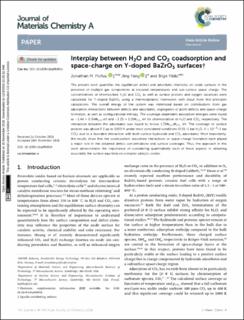| dc.contributor.author | Polfus, Jonathan M. | |
| dc.contributor.author | Yang, Jing | |
| dc.contributor.author | Yildiz, Bilge | |
| dc.date.accessioned | 2020-12-28T13:50:11Z | |
| dc.date.available | 2020-12-28T13:50:11Z | |
| dc.date.created | 2018-12-13T11:05:31Z | |
| dc.date.issued | 2018 | |
| dc.identifier.citation | Journal of Materials Chemistry A. 2018, 6 24823-24830. | en_US |
| dc.identifier.issn | 2050-7488 | |
| dc.identifier.uri | https://hdl.handle.net/11250/2721035 | |
| dc.description.abstract | The present work quantifies the equilibrium defect and adsorbate chemistry on oxide surfaces in the presence of multiple gas components at elevated temperatures and sub-surface space charge. The concentrations of chemisorbed H2O and CO2 as well as surface protons and oxygen vacancies were calculated for Y-doped BaZrO3 using a thermodynamic framework with input from first-principles calculations. The overall energy of the system was minimized based on contributions from gas adsorption, interactions between defects and adsorbates, segregation of point defects and space-charge formation, as well as configurational entropy. The coverage dependent adsorption energies were found as −1.44 + 0.34ΘH2O eV and −2.25 + 1.21ΘCO2 eV for chemisorption of H2O and CO2, respectively. The interaction between the adsorbates was found to follow 1.72ΘH2OΘCO2 eV. The coverage of surface protons was above 0.3 up to 1000 K under most considered conditions (0.01–1 bar H2O, 4 × 10−4–1 bar CO2) due to a favorable interaction with both surface hydroxide and CO2 adsorbates. Most importantly, the results show that the coadsorption, adsorbate interactions or space-charge formation each played a major role in the obtained defect concentrations and surface coverages. Thus, the approach in this work demonstrates the importance of considering quantitatively each of these aspects in obtaining accurately the surface equilibria on complex catalytic oxides. | en_US |
| dc.language.iso | eng | en_US |
| dc.publisher | Royal Society of Chemistry Publishing | en_US |
| dc.rights | Navngivelse 4.0 Internasjonal | * |
| dc.rights.uri | http://creativecommons.org/licenses/by/4.0/deed.no | * |
| dc.title | Interplay between H2O and CO2 coadsorption and space-charge on Y-doped BaZrO3 surfaces | en_US |
| dc.type | Peer reviewed | en_US |
| dc.type | Journal article | en_US |
| dc.description.version | publishedVersion | en_US |
| dc.rights.holder | Open Access Article. Published on 19 November 2018. This article is licensed under a Creative Commons Attribution 3.0 Unported Licence. | en_US |
| dc.source.pagenumber | 24823-24830 | en_US |
| dc.source.volume | 6 | en_US |
| dc.source.journal | Journal of Materials Chemistry A | en_US |
| dc.identifier.doi | 10.1039/C8TA09491H | |
| dc.identifier.cristin | 1642589 | |
| dc.relation.project | Norges forskningsråd: 228355 | en_US |
| dc.relation.project | Norges forskningsråd: 257579 | en_US |
| dc.relation.project | Notur/NorStore: nn9259k | en_US |
| cristin.unitcode | 7401,80,62,0 | |
| cristin.unitname | Bærekraftig energiteknologi | |
| cristin.ispublished | true | |
| cristin.fulltext | original | |
| cristin.qualitycode | 1 | |

